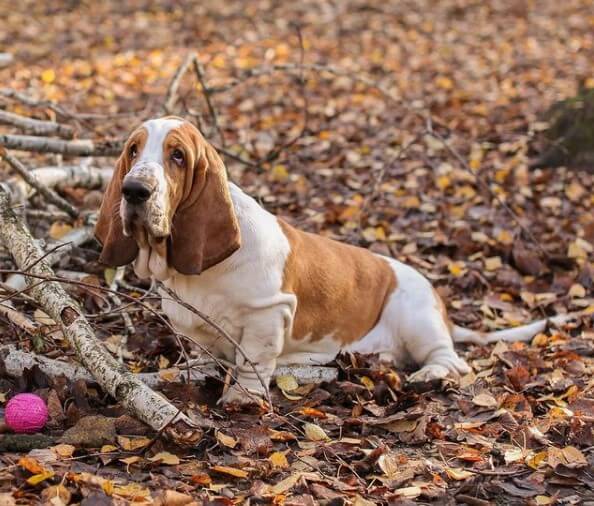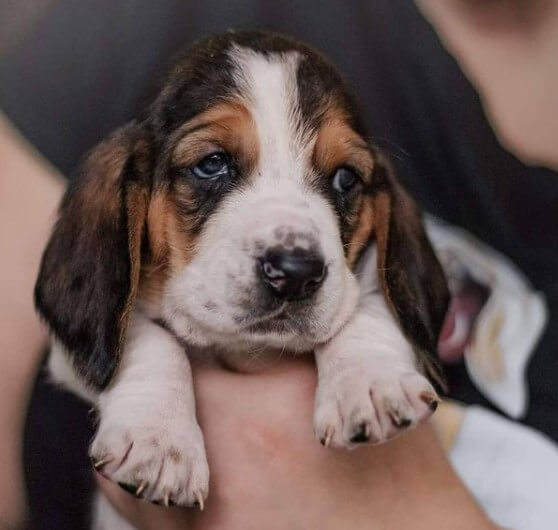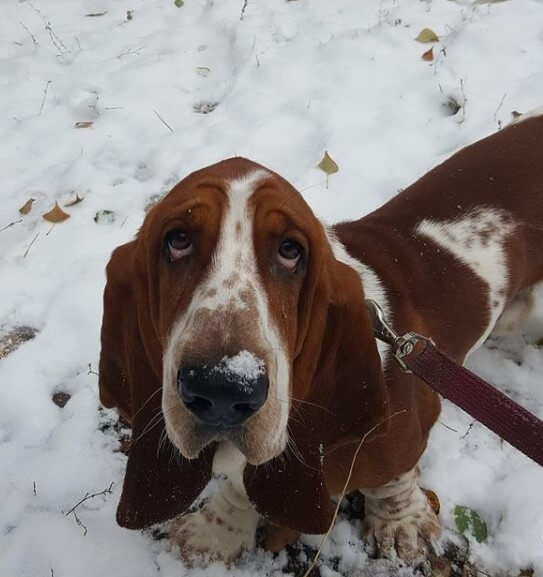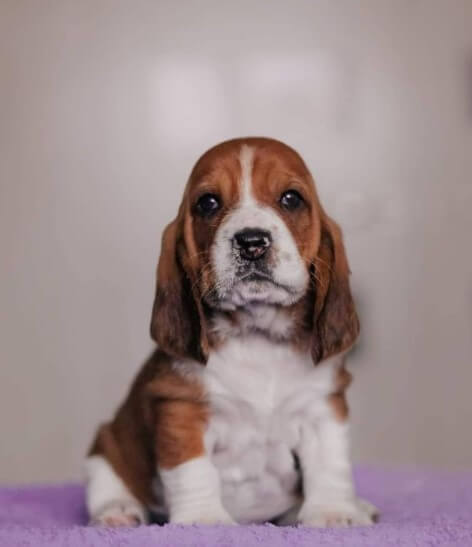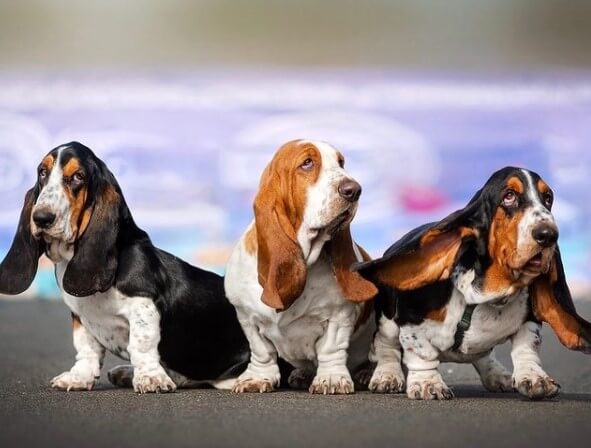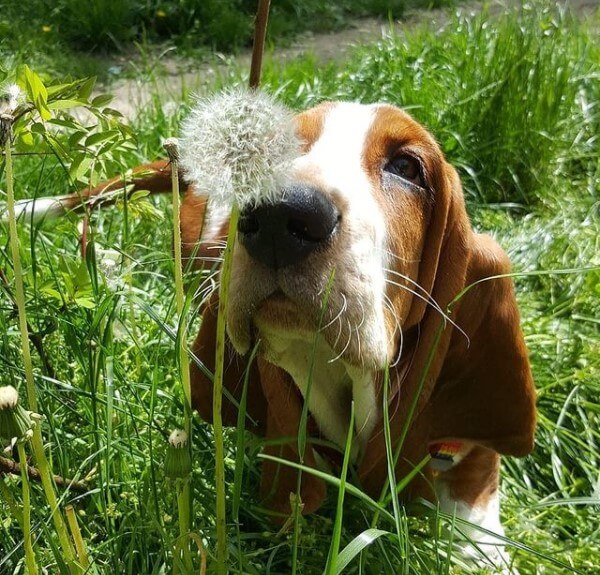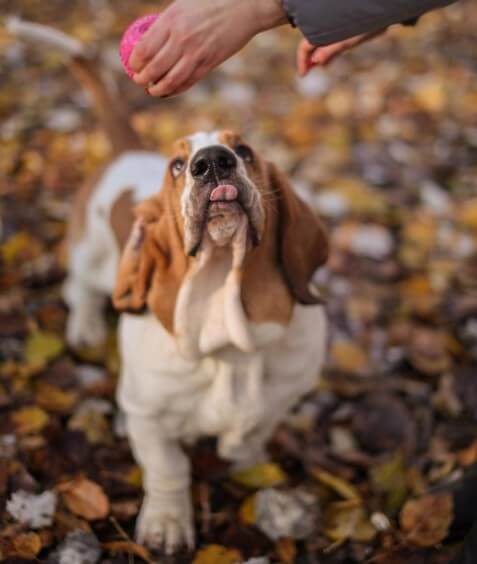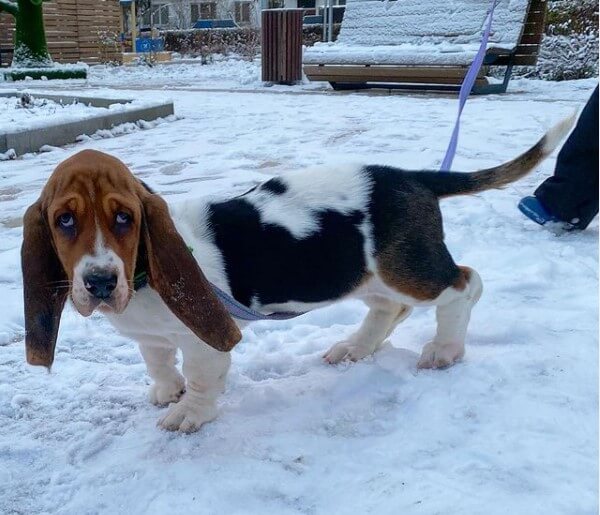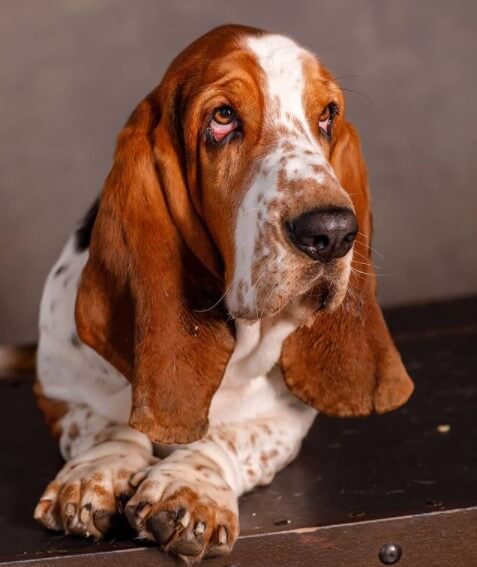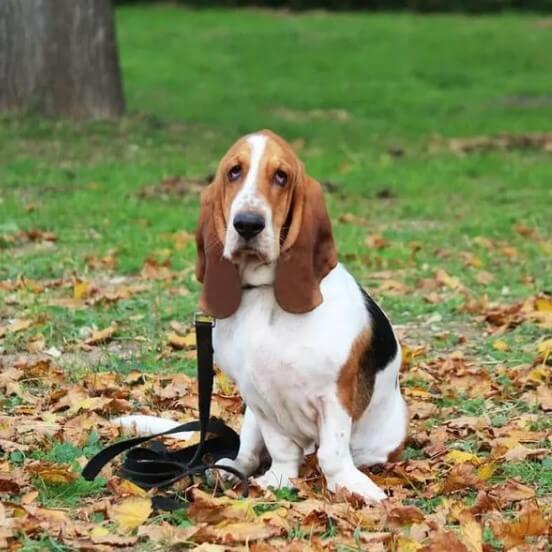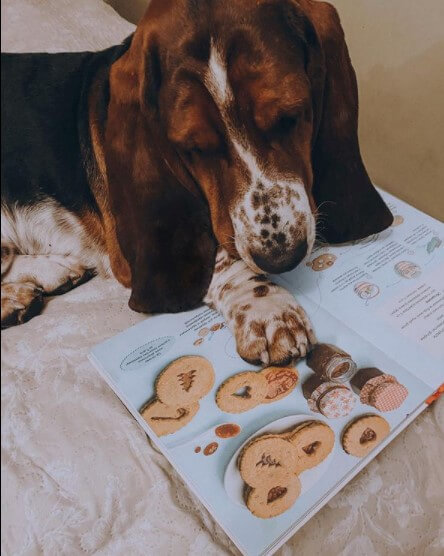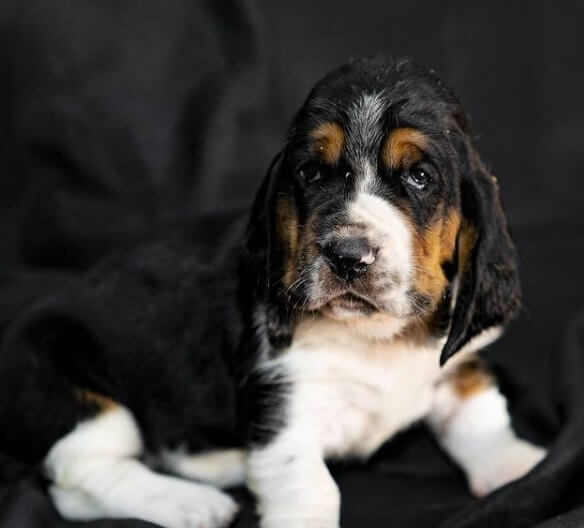Basset Hound is a dog that looks like a sad aristocrat, he seems immensely melancholic. But the dog is by no means a melancholic, but a rather sociable and cheerful pet. However, to say that it is always easy and natural with a Basset Hound would be half true. Possessing outstanding intellect and a reserve of a healthy selfishness, the stocky “gentleman” rarely gives up his principles and comfort on demand. Therefore, if you want to get along with the breed, be prepared to respect its habits and interests – there is no other way with a Basset Hound.
Brief Information
- Breed Name: Basset Hound
- Country of origin: United Kingdom
- Time of origin of the breed: XX century
- Weight: males 25-34 kg, females 20-29 kg
- Height (height at the withers): males 30-38 cm, females 28-36 cm
- Life span: 10-12 years
Highlights
- For their love of comfort and soft couches in England, Basset Hounds were dubbed “couch athletes.”
- Basset Hounds have a sonorous, deep voice that they willingly use in the absence of the owner. Accordingly, if you live in an apartment and will often leave the dog alone with his own thoughts, its howls can seriously damage your reputation in the eyes of neighbors.
- The breed is distinguished by remarkable intelligence, combined with moderate stubbornness, which turns its representatives into loyal, but not the most accommodating pets.
- Basset Hound is an addicting nature. If during a walk the dog attacked the trail of the animal, it is almost impossible to revive it and distract it from the search for potential prey.
- The Basset Hound is eternal saliva. A lot of salivae. And water will constantly spill on the floor near the drinking bowl.
- Literally dragging on the floor “toy” paws and ears do not interfere with the hunting talents of Basset Hounds, so with timely training, they are able to hunt a rabbit or pheasant.
History of the Basset Hound Breed
Officially, the Basset Hound is considered an English breed, but the birthplace of its ancestors was still France. Starting from the Middle Ages, in the books and manuscripts of French historians, notes began to slip about squat dogs from the tribe of Artesian-Norman Hounds, who were involved in burrowing and searching for truffles.
In written sources, the animals figured under the name Bassets and were depicted as short-legged dogs with massive bones. By the way, the characteristic short stature inherent in all modern representatives of this family was an elementary mutation, which was subsequently artificially fixed by breeders.
In the 17th century, Basset breeding became widespread in France, as a result of which the breed expanded the list of “qualifications”. Now with short-legged dogs, they went not only to burrowing animals but also to pheasants. It is clear that it was mainly hunting on foot since the Bassets simply could not keep up with the horse, but they perfectly managed to wade through the thicket and dive into the forest for prey.
Around this stage, the stratification of the family of stunted dogs began. As a result: by the 18th century, in French kennels, one could find 12 lines of Basset, different in appearance and performance, some of which later “merged” into the so-called Artesian-Norman type.
The English stage of the breed’s development began in the 19th century when the Artesian-Norman Bassets crossed the English Channel. In the homeland of Shakespeare, the animals immediately added a “national flavor”, mating them with Bloodhounds, which gave the dogs’ body solidity and slight “folding”, and their ears – an impressive length. The offspring obtained as a result of the crossing was named Basset Hounds, presented at the Paris Exhibition in 1863.
About 20 years after the official announcement, the Basset Hounds had their own club, and in 1887 they finally separated from the rest of the Basset types, having passed the standardization procedure. At the end of the 19th century, the breed was already well known in America.
Basset Hound Breed Standard
The Basset Hound stretched out on the rug gives the impression of a clumsy woolen caterpillar, in which it is difficult to suspect a hunter. Nevertheless, the dog is perfectly adapted to chasing prey in rough terrain: the short legs of the Bassets can easily overcome the “traps” of uneven terrain, which is beyond the power of other varieties of hounds.
The mournful expression of the muzzle, characteristic of the representatives of this breed, is their exclusive exterior highlight. The Basset Hound can be peaceful, enthusiastic, angry, but all these mood swings will be accompanied by a single sad face.
It is impossible to ignore the long, hanging almost to the ground ears of the breed, resembling drooping wings. When Basset has gained sufficient speed, they flutter under the pressure of the wind, creating the illusion that the dog is about to take off.
The height of the Basset Hound at the withers, according to the standard, should be 33-38 cm. Dogs weighing from 18 to 29 kg.
Additional Characteristics:
- The coat is short and smooth, close to the body.
- Skin folds on the paws are allowed, but there should not be too many of them.
- The ears are set below the eye line as standard.
- The eyes must be diamond-shaped, dark in color, brown eyes are allowed in light-colored Basset Hounds.
- A muscular, powerful neck with a well-defined dewlap.
- Low-set body, which is significantly longer than its height.
- The back and chest should be broad and strong.
Coat and Color
The Basset Hound’s coat is short and tight to the body.
In theory, Basset Hounds can have any color characteristic of a hound. In reality, dogs are most often tricolor (for example, black and white with reddish tan marks) and two-colored (reddish-white).
Personality
The Basset Hound, in spite of its amusing, emphatically awkward appearance, is still a dodger, both in terms of physiology and intellectual indicators. Proud and proud, he not only painfully reacts to criticism and infringement of personal rights, but is also able to develop and then put into action a plan of small revenge on the one who angered him, so if one day you find a suspicious stain or a bunch on your favorite carpet, do not rush to be indignant … It is possible that the Basset Hound did it on purpose in response to yesterday’s offense.
Representatives of this breed have their own views on life, which does not prevent them from being on good terms with the owners. Don’t look at the sad face. Inside the Basset Hound, the creatures are sociable and very cheerful. For example, at home, a dog behaves like this: it stuffs its stomach with treats until it swells like a bubble, rolls around on sofas, wrapped in its ears, hangs around near its master’s legs, waiting for affection. In general, with all his appearance he shows that he knows a lot about pleasures.
As befits a real hound, the Basset Hound is absolutely not aggressive. Of course, if you try, you can make any dog angry, but in general, the breed will not grumble and bite. Moreover, the Basset Hound is able to tolerate a number of other dogs and much less often cats. Naturally, no one will oblige to transfer patience to all animals, without exception. But if you introduce the “eared” with the rest of the domestic fauna in advance, he will not terrorize them either.
Representatives of this breed categorically do not want to give up their favorite habits, preferring to change the lifestyle of their own owners as a compromise. For example, all Basset Hounds are tightly “hooked” on comfort, so if the pet has chosen a specific place in the apartment, it is almost impossible to move its shelter to another part of the house.
The solitude and loneliness of the dogs are also not happy, so if for some reason you did not take the Basset Hound with you, and he really wanted to, get ready for small dirty tricks. They adore eared ears and lie on sofas, from the first months of life, almost reflexively climbing onto the master’s bed. Moreover, a secret passion for soft featherbeds remains even among those individuals who, it would seem, have been weaned from this habit. Left the house for an hour? You can rest assured that Basset Hound will not miss the opportunity to take advantage of your absence and relax on your own bed.
Training
Basset Hounds are sociable and amusing dogs, but zealously protecting their own interests. For example, they love to adapt the educational process to their needs and will try to break the rules of the game more than once if they are not satisfied with something. Accordingly, if you decide to raise an obedient pet, then do not make exceptions while the puppy is small and defenseless. Not that Basset is such a pathological stubborn, it’s just that he is too smart not to try to bargain for his favors.
An experienced owner or a specialist in a kennel club should teach the dog the rules of behavior in the house and teams, although this does not mean that the animal needs to be “pressed”. Instead, try to look at the activity through the eyes of your pet, which will allow you to understand his desires and aspirations. With the right approach, the Basset Hounds quickly understand all disciplines of obedience, as well as all kinds of dynamic competitions like agility.
However, one should not rely on the breed’s impeccable performance. After all, Bassets are not service dogs, and they quickly get bored with constant tugging. Therefore, you will have to be aware of the fact that one day your ward will deliberately “not hear” the call or prohibition.
The best incentives for working with Basset Hounds were and still are delicious rewards. The main thing is to skillfully play on the breed’s tendency to gluttony and not overdo it. It is advisable not to use negative reinforcements at all. Do not forget that the Basset Hound is touchy and will definitely respond to the infringement of personal rights with some kind of harm. However, if the animal persists and deliberately fouls, it is not forbidden to slightly slap it with a twig. A traditional rolled-up newspaper is not an option, Bassets are literally thick-skinned creatures.
The duration of lessons for the breed should be kept to a minimum. The maximum that the Basset Hound can tolerate is 10 minutes, after which the dog will need an emotional “reset”.
In addition to standard training, Basset Hounds are taught to put up with forced loneliness. A pet left in an apartment for an hour or two should not frighten neighbors and passers-by with “opera arias”. It is clear that one cannot achieve one hundred percent silence with this breed, but talkativeness can be reduced. From the first days after moving to a permanent place of residence, disaccustom the puppy to “collect” the master’s things, which is a kind of hobby for Basset Hounds. Hide all your shoes from the big-eared joker, even if they are old and it’s time to throw them away. Remember, the animal doesn’t know the difference between worn-out shoes and just bought sneakers, so it chews on them with the same passion.
Conditions of Detention
Unlike its French ancestors, today’s Basset Hound is not well suited for life in the yard, so its place is in the house. Special conditions for keeping a dog are not required, so you will have to buy all those household items for it as for any apartment breed, that is, a bed bowl for food and water, toys, a tray, a leash, a collar, and other accessories.
Up to six months, all movements of puppies around the house must be monitored. At this age, the short legs of a Basset Hound are fragile, unstable, and injured even with minor jumps, for example from a sofa. Stairs under 6 months of age are best avoided, or climb and descend with your pet in your arms.
Hygiene
Basset Hounds shed in autumn and spring, but this does not mean that combing their short hair is necessary at the same frequency. Massage your pet’s skin and hair follicles with a soft brush, if not daily, then at least a couple of times a week. This, firstly, stimulates blood circulation in the deep layers of the skin, and secondly, improves the structure of the hair.
As for the smell of a dog, then in Basset Hounds, it appears only when the coat gets wet. Bassets, which are bathed at least twice a month, also exudes the “scent” of a muton fur coat, but it is usually not too pronounced and does not irritate the sense of smell. By the way, “boys” and individuals with a lot of folds always smell more intense.
Basset Hound ears require special attention. Not only that, when bathing the dog, you will have to constantly monitor whether water has entered the ear canal, you need to allocate time for daily “inspection” of the ear funnel and ventilation.
There is also a full observation of the pet’s face. Basset Hounds are still slobbering and their water drinking habits are specific (splashes and puddles fountain in all directions), so you have to watch the dog with a towel willy-nilly. Basset Hound eye hygiene consists of rubbing the mucous membrane with herbal infusions (tea, chamomile). Remember to take care of your dog’s thick paws by cleaning them after walking with a damp cloth and trimming the nails about a couple of times a month.
Walking and Hunting
Basset Hounds are real secret agents. As soon as the dog leaves the confines of its home, it instantly turns into a stubborn tracker. Remember about the peculiarities of this breed and do not let the animal off the leash near the track. The standard walking mode for a Basset Hound is morning and evening, about an hour. However, if it is possible to take your pet outside more often, this is a big plus. A healthy Basset Hound will never give up on an extra walk, and unplanned walks are especially beneficial for puppies with unformed toilet etiquette.
Basset Hound walks should take place at a lively yet relaxed pace. Do not burden dogs with marathon runs – the breed is not made for them. It is better to walk with your pet down the street, play ball, or catch-up, but without fanaticism.
Basset Hounds’ main working qualification is hunting for traces of blood, which they did brilliantly in England. The strong short legs of the dog were very useful here, helping to wade into the dense thickets of bushes and rhizomes. Funny ears of the breed are also a useful “accessory”. The canvas fluttering on the run “caught” the smell of the game and transferred it to the dog’s nose.
Feeding
The Basset Hound is a fast-growing breed. In particular, at 3.5 months, the puppy’s milk teeth are completely replaced by permanent ones, and its skeleton gradually finishes forming. In connection with this feature, babies need to be fed nutritiously from the first months of life. The main dish for Basset Hound puppies is porridge with beef, in addition to which you can give low-fat kefir or fermented baked milk. The approximate serving size for a 2-month-old puppy is 100-200 g; for 3-4-month-old puppies – 400 g; from 4 to 6 months – 500-600 g.
It is customary to transfer 10-month-old Basset Hounds to two meals a day and an adult diet. At this age, the breed can do almost everything, including offal, fish fillets, vegetables (except potatoes and legumes), fruits, cereals, and as a rare delicacy – marrow bones. Feeding with calcium, phosphorus, and vitamin D is another must-have item on the “menu” for both adolescents and adults Bassets: the load on the joints of the breed is colossal.
Growing puppies can benefit from adding chondroitin and glucosamine supplements to their feed to prevent crooked legs. But a special gastronomic variety of Basset Hounds is not required. If the dog is healthy and active, it will eat anything that smells edible.
Throwing food into a bowl and forgetting about the Basset Hound will not work: carried away by the process, he will definitely rinse his ears in a bowl. To prevent this from happening, it is better to tighten the ears with an elastic band at the back of the head. In addition, after a meal, a small amount of food remains in the cheek pouches of a Basset Hound, which eventually begins to smell unpleasant. You will have to get rid of rotting residues manually: open the dog’s mouth and remove the decomposing gruel with a cloth.
Health
Basset hounds are dogs with their weak points. For example, like any fold-eared breed, they are prone to otitis media. Willebrand disease (a bleeding disorder) was inherited from their ancestors, just like allergies to certain plant species and a tendency to volvulus. The wide, chubby paws of Basset Hounds are another vulnerable spot where abscesses, fungus, and interdigital cysts sometimes occur.
Panosteitis is a rather unpleasant breed of disease. The ailment is accompanied by temporary lameness, which is why it is often confused with hip dysplasia and dislocation of the patella. Panosteitis manifests itself only in puppies, does not require surgical intervention, and by the age of two, it ceases to bother the animal. However, due to the difficulty of diagnosing Basset Hounds with this disease, they are mistakenly operated on, which does not have the best effect on the dog’s health.
How to Choose a Puppy
- If you didn’t manage to meet professional breeders of Basset Hounds at the show, contact the breed club, where there are always addresses of reliable kennels.
- Examine and compare at once a couple, or better three litters.
- Gently feel the tail of your favorite Basset Hound puppy. It should be smooth and firm. Kinks and distortions are a significant flaw that is worth bargaining for to bring down the price.
- Examine the paws of the babies carefully. Preference – Basset Hound with thick, straight legs, indicating the solidity of the skeleton.
- Unfold the puppy’s ears and look into the ear canal. There should be no crusts and sulfur in it, as well as an unpleasant smell.
- Flip the little Basset Hound on its back and examine its abdomen for excessive swelling and hernia.
- Observe how the puppy you are interested in behaves in the pack, whether it eats with appetite, whether it is not frightened by every rustle.
